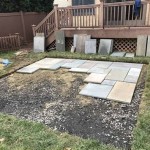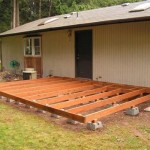DIY Patio Design: Creating Your Outdoor Oasis
Designing a patio involves careful planning and execution. Transforming a blank space into a functional and aesthetically pleasing outdoor living area can be a rewarding experience, often achieved through do-it-yourself (DIY) projects. This article will explore essential aspects of DIY patio design, offering guidance on key considerations and practical steps to construct a patio that meets individual needs and complements the existing landscape.
Planning and Preparation
The initial phase of any DIY patio design project centers on meticulous planning. Accurate assessment of the available space is paramount. Measure the intended area to understand its dimensions and shape. This will inform decisions about the patio's size and layout, ensuring it harmonizes with the surrounding yard. Consider existing structures, such as the house, fences, or trees, to integrate the patio seamlessly into the environment. It is important to note any underground utilities. Contacting local utility companies to mark buried lines ensures safety and prevents accidental damage during excavation.
Once the dimensions are established, defining the patio's purpose is crucial. Will it primarily serve as a dining area, a relaxation space, or an entertainment hub? The intended use will dictate the required size and features. A dining area necessitates sufficient space for a table and chairs, while a relaxation zone may benefit from comfortable seating arrangements and shade structures. Entertainment patios might require ample room for guests, outdoor kitchens, or fire pits.
Developing a detailed design plan follows the space assessment. This plan should include a scaled drawing of the patio, indicating dimensions, materials, and placement of features. Sketching different layout options allows for visual exploration and optimization of the design. Take into account sun exposure, prevailing winds, and privacy considerations. Designing for adequate drainage is also critical, as standing water can damage the patio and create safety hazards. A slight slope away from the house will facilitate water runoff. Furthermore, explore different material options, such as pavers, concrete, stone, or composite decking. Each material offers unique aesthetic qualities, durability, and cost considerations. Gather estimates for all materials required to accurately calculate the project budget. Creating a realistic timeline for the project will help manage expectations and ensure timely completion.
Material Selection and Installation
Selecting appropriate materials is essential for durability and aesthetics. Pavers offer a diverse range of colors, shapes, and textures, providing ample design flexibility. Concrete is a cost-effective and versatile option that can be stamped, stained, or textured to achieve various looks. Natural stone, such as flagstone or slate, lends a rustic and elegant touch to the patio. Composite decking provides a low-maintenance alternative to wood, resisting rot, insects, and fading. Consider the climate and soil conditions when selecting materials. In regions with freeze-thaw cycles, choose materials that are resistant to cracking and heaving. Soil type influences the base preparation required for paver or stone patios. Sandy soil drains well, while clay soil requires more extensive drainage measures.
Proper base preparation promotes a stable and long-lasting patio. Excavate the area to the required depth, typically 6 to 8 inches, depending on the chosen materials and soil type. Remove any vegetation, roots, and debris. Compact the soil thoroughly using a plate compactor. This creates a solid foundation for the base materials. Add a layer of gravel base, typically 4 to 6 inches thick, for drainage and stability. Compact the gravel base in layers, ensuring a level and even surface. A layer of sand, typically 1 to 2 inches thick, provides a smooth setting bed for pavers or stones. Level the sand bed carefully using a screed board. Precise leveling is crucial for a uniform and even patio surface. Apply polymeric sand between the pavers or stones to lock them in place and prevent weed growth. Polymeric sand hardens when exposed to water, creating a durable and stable surface.
Installing pavers or stones requires precision and attention to detail. Begin by laying out the pavers or stones according to the design plan. Maintain consistent spacing between each piece using spacers. Cut pavers or stones as needed using a masonry saw to fit edges and corners. Ensure that the cuts are clean and precise for a professional finish. Use a rubber mallet to gently tap the pavers or stones into the sand bed, ensuring they are level and firmly set. Regularly check the levelness of the patio surface using a level. Make adjustments as needed by adding or removing sand beneath the pavers or stones.
Enhancing the Patio Space
Once the patio surface is complete, several elements can be added to enhance its functionality and aesthetic appeal. Incorporating seating arrangements creates a comfortable and inviting atmosphere. Outdoor furniture, such as chairs, sofas, and benches, provides ample space for relaxation and socializing. Consider the material of the furniture, opting for weather-resistant options that can withstand the elements. Wicker, aluminum, teak, and synthetic fabrics are excellent choices for outdoor furniture. Adding cushions and pillows in coordinating colors and patterns enhances comfort and style.
Shade structures provide protection from the sun and rain, making the patio more enjoyable during all seasons. A pergola offers partial shade and can be adorned with climbing plants for a natural touch. A retractable awning provides adjustable shade and can be easily retracted on cloudy days. An umbrella offers portable shade and can be moved as needed. Consider the orientation of the patio when selecting a shade structure. Position the structure to block the sun during the hottest hours of the day.
Landscaping complements the patio and integrates it into the surrounding environment. Planting flowers, shrubs, and trees adds color, texture, and visual interest. Use containers to add greenery to the patio surface, creating a vibrant and inviting space. Consider the mature size of plants when selecting species. Choose plants that are appropriate for the climate and soil conditions. Install landscape lighting to illuminate the patio at night, creating a warm and inviting ambiance. String lights, pathway lights, and spotlights can highlight architectural features and landscaping. Outdoor lighting enhances safety and extends the usability of the patio into the evening hours.
Adding a fire pit or outdoor fireplace creates a focal point and provides warmth during cooler evenings. Fire pits can be constructed from various materials, such as stone, brick, or concrete. Outdoor fireplaces offer a more substantial and permanent option. Ensure that the fire pit or fireplace is located a safe distance from combustible materials. Follow local fire codes and regulations when installing a fire feature.

Diy Stone Circle Patio Design Able Plan Mypatiodesign Com

Diy Patio Addition Design Able Plan Mypatiodesign Com

50 Patio Ideas For The Backyard Of Your Dreams

Patio Design Ideas Garden Gate

Diy Small Brick Patio Design Able Plan Mypatiodesign Com

24 Backyard Makeover Ideas You Ll Love Extra Space Storage
:strip_icc()/102182127-c245b9eb3d7b4d8daaf7f512bace802c.jpg?strip=all)
Find Inspiration For Outdoor Spaces In These 21 Diy Patio Ideas

Diy Patio Plan With Two Seating Walls And Fire Pit 320 Sq Ft Small Design Plans Landscaping

52 Simple Patio Design Ideas To Really Eoy Your Outdoor Relaxing Moment Matchness Com Concrete Designs

58 Beautiful Outdoor Patio Design Decor Ideas A Piece Of Rainbow








